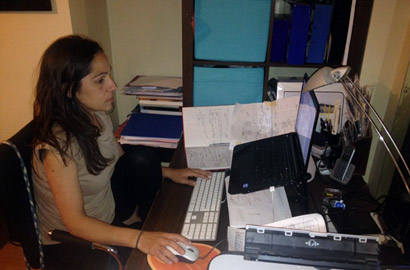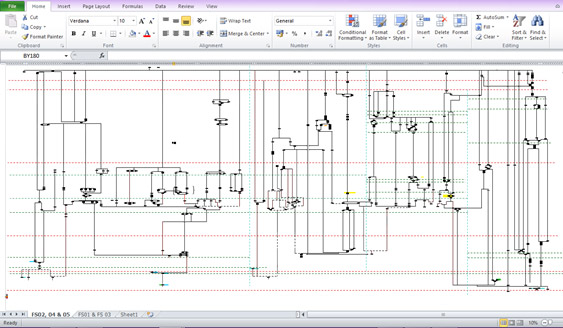By Freya Sadarangani and Dan Jones
Whilst the students and teachers of the Mit-Rahina Field School (MRFS) study season take the minibus each day from Giza to the work room in Mit-Rahina (Memphis) the two of us are frustratingly housebound – Dan in the Giza archive and Freya at her desk in York, UK. With there being digital versions of our Mit-Rahina excavation and post-excavation records and because we can talk regularly using Skype it is surprisingly easy to work together, given that we are separated by some 3,500 kilometres.

Freya working from the UK

Dan working from Egypt
Our remit this season is to produce a publishable article on the 2011 Mit-Rahina site’s stratigraphic sequence – detailing how the site developed over time. This will be done in collaboration with Egyptian colleagues from the Ministry of State for Antiquities (MSA) who were teachers during the 2011 season. Our first job has been to pull out the complete excavation archive from 2011 (record forms, drawings, photographs, reports, survey data, drill core data, stratigraphic matrices), double check that everything has been digitised and that there are no erroneous niggling gaps lurking in the archive. We also need to make sure that the specialists have everything they need from us to complete their own work and teaching.
After the 2011 season the excavation team (teachers and students) produced a full post-excavation archive (including a stratigraphic matrix and an end of season site report- what we call Data Structure Reports). Our second phase of work this season will be to go through that stratigraphic matrix (which is a graphic representation of stratigraphic relationships – above, below and same as – between individual archaeological features) with a fine tooth comb, tying in chronological information provided by the specialists – so for example when we hear from the ceramicists that a particular feature (deposit or wall) contained 13th Dynasty pottery we know that that feature had been deposited in or after the 13th Dynasty (not before). We recorded 680 archaeological features in 2011 so this is no mean task. This will allow us to phase the stratigraphic sequence of features that we excavated into a chronological sequence and analyse and report on how and specifically in what ways the site developed over time. Armed with this, we will work closely with Rebekah Miracle, our GIS expert, who will produce maps that graphically represent the site’s development (more on this from Rebekah in a later blog). So far, based on the pottery we think we have 7 chronological phases of activity mainly ranging between the 1st half of the 12th dynasty to the 13th dynasty (but also stratigraphically earlier, but undated features, and post- 13 dynasty activity).

One half of the stratigraphic matrix for the features the team excavated in 2011, constructed using Excel and horizontally ordered into provisional chronological phasing. Each black blob (the detail is not great zoomed out) is a unique number representing individual archaeological features.
Our third phase of work will be research, seeking out relevant publications that will help us refine and support our interpretations of the site’s narrative. This will lead on to our final phase of work – the writing and illustration of the Mit-Rahina site article. Yup, a lot to do in a month!
